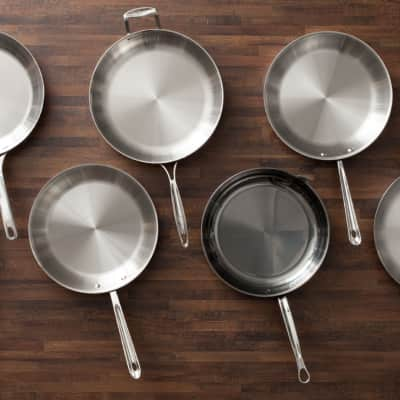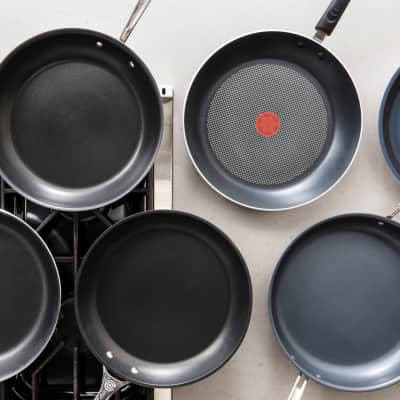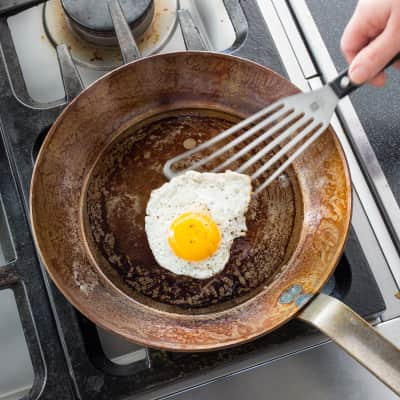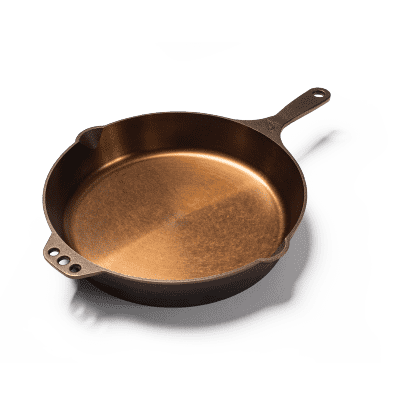A well-made skillet is arguably the most critical piece of cookware in your kitchen, and there are four types that we consider essential: fully clad stainless steel, nonstick, carbon steel, and cast iron. Each features a unique metal composition and construction that gives it particular skills—and limitations. Here’s a diagnostic breakdown of each pan.
The Four Core Skillets You Should Own—According to Science
Published Nov. 30, 2021.


Fully Clad Stainless Steel
Construction: The entire body of the pan, versus just the bottom, is composed of three or more layers of different metals bonded together. In our favorite, aluminum is sandwiched between stainless steel. That means you get the best of both metals: aluminum’s speedy heat conduction modulated by slower-transmitting, heat-retaining steel for a pan that heats evenly and holds onto it. Don’t bother with pans that have more than three layers—we’ve found these are heavier and, depending on the material of the additional metal, can heat more slowly.
Why We Love It: This is the ideal material for pan sauces and braises because food sticks to it, creating flavorful fond, and because it won’t react with acidic items such as tomatoes, vinegar, or wine. The light-colored pan makes it easy to monitor the progress of dark foods such as browned butter, and it can take a beating. Sauté, sear—even blast it under the broiler—and then scrub the heck out of it.
Limitations: Sticking, which is an asset for fond development, is a liability for delicate, clingy foods such as eggs and fish fillets.
The Best Stainless-Steel Skillets
Perfect searing, flavorful sauces, and stove-to-oven versatility make stainless-steel frying pans essential to home kitchens. Which is best?
Nonstick
Construction: Sprayed over the lightweight aluminum base is a superslick coating primarily composed of PTFE (trade name teflon), a slick, heat-resistant plastic.
Why We Love It: Stick-prone items such as eggs and fish fillets practically glide across the slick surface. Since you don’t need to add oil to the pan, nonstick is also a splatter-free way for searing steaks and chops when you don’t want a flavorful fond for building a sauce. (When searing, we use our cold-start method to avoid overheating the nonstick coating; for more information, see our recipes for Pan-Seared Thick‑Cut, Bone-In Pork Chops and Pan-Seared Strip Steaks.)
Limitations: The coating wears out with use, especially over high heat (above 500 degrees, it can break down and release dangerous fumes) and if scrubbed too hard or scratched with metal tools. Given that, it pays to buy relatively inexpensive pans from a reputable manufacturer that can be replaced regularly.
Traditional Nonstick versus Ceramic Nonstick:
Ceramic pans get their nonstick properties from a form of silica (also found in beach sand). Their surfaces are more brittle than nonstick surfaces composed of PTFE, so they can develop microscopic cracks that can cause food to stick. Pure ceramic pans can be used at high temperatures with no risk of dangerous fumes, but shop carefully, since many ceramic coatings contain PTFE (our winning ceramic pan is PTFE‑free). Like all nonstick cookware, these pans will eventually need to be replaced.
Favorite Ceramic: GreenPan Valencia Pro Hard Anodized Nonstick Frypan
The Best Nonstick Skillets
These pans are wildly popular for a reason. When you have a good one, food never sticks and cleanup is a breeze.
Carbon Steel
Construction: The composition of carbon steel, an alloy made of about 1 percent carbon and 99 percent iron, makes it a particularly functional material for cookware. It contains slightly less carbon than cast-iron, which makes it less brittle; as a result, it can be made relatively thin and lightweight but still be plenty durable. It’s heavy enough to retain heat well but thin enough to heat quickly. Its naturally smooth surface makes it easy to acquire a slick patina of polymerized oil during seasoning; that said, its patina is thinner and less durable than the seasoning on cast iron.
Why We Love It: Carbon steel is a jack of all trades and master of many. It’s thick and sturdy enough to sear nearly as well as cast iron, but maneuvers almost as nimbly as fully clad stainless steel. And assuming it’s well seasoned, it’s as slick as nonstick—but naturally so, boasting a supersmooth patina that improves (instead of degrades) with use. The price is right, too. Bar none, it’s the most high‑value pan in the test kitchen.
Limitations: Unlike most cast-iron pans, carbon-steel pans are sold unseasoned, so you need to start from scratch. A truly slick patina requires many rounds of seasoning and careful maintenance. Acidic foods such as tomato sauce will react with the metal and strip off its coating.
Tip: See Our Methods for Seasoning Carbon Steel and Cast Iron
These surfaces get slicker with use as heated fat molecules link up to form a hard film that bonds to the metal’s surface. Here are our methods for seasoning and maintaining cast iron and carbon steel.
The Best 12-Inch Carbon-Steel Skillets
What if one pan could do everything the best traditional stainless-steel, cast-iron, and nonstick pans can do—and, in some cases, even do it a little better?
Cast Iron
Construction: Thick and heavy, the high-sided frame is composed of 97 to 98 percent iron and 2 to 3 percent carbon. Its pebbly surface contains relatively deep nooks and crannies that tightly grip seasoning, which, with continued and careful use, will become a naturally nonstick patina that protects the surface from rust and releases food readily.
Why We Love It: Once it’s hot, cast iron holds heat exceptionally well (even when cool food is added), which makes it ideal for frying, searing, and roasting. Its tall, straight sides also make it well suited for deep-dish applications such as cornbread, pan pizza, and even fruit-packed pies. The patina is endlessly renewable and also protects the metal from rust. You can hand down cast‑iron pans for generations.
Limitations: Its relatively high percentage of carbon makes cast iron a brittle alloy; molding it into a thick, hefty frame makes it durable—but a beast to maneuver and notoriously uneven as it heats up. Like carbon steel, its patina requires gradual buildup and careful maintenance and will react with acidic foods.
Tip: How to Preheat Cast Iron
To ensure that the pan heats thoroughly and evenly, place it on the middle rack of the oven (its convective heat minimizes hot spots) and heat the oven to 500 degrees. When the oven reaches 500 degrees, use pot holders to set the pan over a moderate flame on the stovetop to maintain the heat.








